Blogger’s note:
I originally wrote this blog entry with the intention of asking the editors of Lingoblog to release it shortly before the summer holidays. However, since then another situation has arisen, which to an even higher degree seems to leave people needing something good to read, so I’ve decided instead to submit this entry now, as a guide to quarantine rather than summer reading. I urge you to consider it a bit of tragic irony when I refer to the holidays below, rather than to the current situation.
The libraries here in Denmark may be closed, but there’s still audio- and e-books as well as online bookstores that are accessible without venturing into the public and risking contamination. I hope the books on this list might bring some entertainment to Lingoblog’s readers in these terrifying-yet-tedious times.
LingoLit: A Linguist’s Summer Quarantine Reading Guide
Summer holidays are approaching, and once again, the annual problem for our profession is finding a good way to spend it. For many of us, students as well as teachers, the holidays mean a break from formal linguistic education. And what greater horror could there be for those of us who live and breathe for our field to such a degree that our veins flow not with blood, but with liquid phonemes?
Okay, granted – I may be exaggerating ever so slightly, but the fact remains. Personally, I like to learn about and discuss language all year round, and the holidays are a great opportunity to do so without the looming pressures of formal academia. So just in case anyone else out there feels similarly, I’ve decided to share my own solution and put together a short reading guide for linguistic non-fiction that I’d like to recommend. Below, I have picked ten books that aren’t too technical or heavy reading, and which for the most part don’t require a lot of prior knowledge of the field. I have also intentionally chosen books from a wide array of subfields, in the hopes that as many language nerds as possible will be able to find something they’ll like on the list. Personally I’ve been interested in all of these because I take a general interest in communicating linguistics, but I’d recommend browsing through the list and picking exactly the books that seem interesting to you.
LYNNE TRUSS: EATS, SHOOTS & LEAVES (2003, 204 pages)
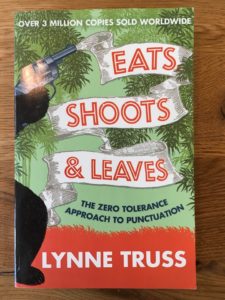 Ironically, I’d like to begin with what’s probably the least linguistic book on this list in spirit. Lynne Truss’ book is widely known as a prescriptivist handbook. I’ve added it to the list as I know that many language fans start taking an interest in linguistics with an expectation of much more grammar policing than is actually the case. And although we as linguists should adhere to descriptivism in scientific contexts, that doesn’t mean we can’t give ourselves over to the glee of correcting punctuation every now and again – as long as we keep a safe ironic distance, of course.
Ironically, I’d like to begin with what’s probably the least linguistic book on this list in spirit. Lynne Truss’ book is widely known as a prescriptivist handbook. I’ve added it to the list as I know that many language fans start taking an interest in linguistics with an expectation of much more grammar policing than is actually the case. And although we as linguists should adhere to descriptivism in scientific contexts, that doesn’t mean we can’t give ourselves over to the glee of correcting punctuation every now and again – as long as we keep a safe ironic distance, of course.
Eats, Shoots and Leaves is a guide to the English language, mainly adressing such topics as commas and apostrophes, but unlike many books of its kind, this one is written with wit, quickly and easily devoured, and full of delicious sarcastic one-liners. I recommend this book for the linguist who still carries around an inner prescriptivist that needs to be fed every now and then.
DAVID J. PETERSON: THE ART OF LANGUAGE INVENTION (2015, 292 pages)
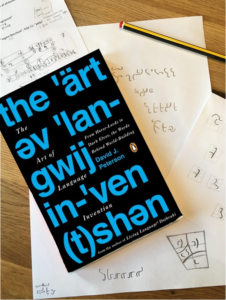 Many a language nerd has toyed with the thought of one day creating their own language. If you have an interest in home-cooked languages – so-called conlangs – , this book is unavoidable. David J. Peterson is best known for having designed the fictional languages Dothraki and High Valyrian for the TV show Game of Thrones, and this book is his step-by-step walkthrough of the process of creating your own language. It’s hard for me to imagine anyone reading this book and not wanting to create their own conlang at the end.
Many a language nerd has toyed with the thought of one day creating their own language. If you have an interest in home-cooked languages – so-called conlangs – , this book is unavoidable. David J. Peterson is best known for having designed the fictional languages Dothraki and High Valyrian for the TV show Game of Thrones, and this book is his step-by-step walkthrough of the process of creating your own language. It’s hard for me to imagine anyone reading this book and not wanting to create their own conlang at the end.
But even for those without immediate conlang-making plans, this is a good introduction to some of the most important subjects of linguistics. The book is divided into four parts, respectively adressing phonetics and phonology; morphosyntax; language evolution; and writing systems. It explains the basic principles in a relatively comprehensive, yet comprehendable manner – the text is easily understood, yet I learned a thing or two even as someone who’s already studied these things formally. Peterson uses his knowledge of natural languages as a template for his fictional ones, making the book not just a handbook for conlangers, but a crash course in the tools of linguistics as a whole.
Peterson writes with an obvious passion for his subject. As a reader, you get the impression of having him right in front of you, vividly explaining his calling. This results in a fairly professional, yet relaxed style of writing. However, it also results in a number of tangents throughout the book – some funny and delightful, some a bit of a stretch. For example, the chapter on morphosyntax doubles as a thinly veiled crusade against onions (read the book and see what I mean).
I recommend this book for those who would like to learn the basic elements of languages, and who might consider making one of their own; and for those with strong opinions on the culinary role of onions.
JOHN POLLACK: THE PUN ALSO RISES (2011, 154 pages)
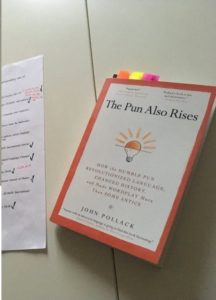 I first came across John Pollack’s book while picking out sources for an exam. Liking the idea of the book, I decided to buy it, and ordered it online; however, due to problems with the retailer my order was cancelled, and I had to put in a frantic one-day delivery order from another retailer the day before my exam. For this reason, I read this book under less-than-ideal conditions: In one nocturnal sitting, the night before being examined in its contents. The fact that I still tremendously enjoyed the book is a testament to its quality.
I first came across John Pollack’s book while picking out sources for an exam. Liking the idea of the book, I decided to buy it, and ordered it online; however, due to problems with the retailer my order was cancelled, and I had to put in a frantic one-day delivery order from another retailer the day before my exam. For this reason, I read this book under less-than-ideal conditions: In one nocturnal sitting, the night before being examined in its contents. The fact that I still tremendously enjoyed the book is a testament to its quality.
However, I have to admit to being biased. The book is about puns, which is one of my personal interests, in life and in linguistics. Nevertheless, I’d say this is interesting reading for language fans, even if you haven’t previously given much thought to the linguistic mechanics of puns. Pollack is not a linguist, but a rhetorician, but his book does focus on just those aspects of puns that would be of interest to a linguist (or at least, the ones that were of interest to this linguist). On top of that, it’s a quick read – as I can attest, it can be done in a single sitting, with sufficient motivation (!).
Most of the book consists of an account of people’s attitudes to puns throughout world history. I find this subject interesting, but the most captivating parts of the book are, in my opinion, the chapters on either side of that, describing respectively the technical anatomy of a pun, and its influence on human language. I recommend this book for those who appreciate a good pun – and for those who have to read it for an exam.
JOHN OLSSON: WORDCRIME (2009, 177 pages)
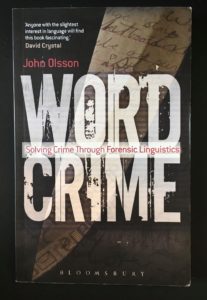 Whenever I’m asked how linguistics is actually of any use, forensic linguistics is one of my favourite examples to turn to. It’s not a big field, but unlike some of the more academic applications of linguistics, it’s very concrete and directly useful. Most people have read Sherlock Holmes or Poirot, seen CSI: Miami, Brooklyn 99 or other, similar media, and most people have some idea that scientific methods can be used to solve crime. This book, written by probably the most prominent expert in the field, contains a number of case studies showing the use of linguistics as a tool of criminology and law.
Whenever I’m asked how linguistics is actually of any use, forensic linguistics is one of my favourite examples to turn to. It’s not a big field, but unlike some of the more academic applications of linguistics, it’s very concrete and directly useful. Most people have read Sherlock Holmes or Poirot, seen CSI: Miami, Brooklyn 99 or other, similar media, and most people have some idea that scientific methods can be used to solve crime. This book, written by probably the most prominent expert in the field, contains a number of case studies showing the use of linguistics as a tool of criminology and law.
The book describes a certain level of technical detail, but is ultimately written more for entertainment than for specific technical insight into the field. Most of all, it belongs to the True Crime genre, since the cases it contains are real trials (though often with details changed to protect individuals’ anonymity). This lends an amazing punch to the book, as I regularly had to remind myself that the sometimes ridiculous, sometimes gruesome contents of the book had actually happened in real life. For this reason, the book also has a slightly bizarre mix of tones. In some of the cases, it’s hilarious to hear of the ridiculous missteps of petty criminals; in others, it’s downright heartbreaking to hear of the consequences suffered by innocents. For this reason, I feel this book deserves a content warning for some of the cases.
A lot of puzzling decisions were made when creating the structure of this book. For example, it ends very suddenly after the final case, where one might have expected a short afterword from the author. The book is also divided into three parts for no apparent reason, since each part consists of a handful of seemingly unrelated cases. Other than that, I was occasionally distracted by Olsson’s rather idiosyncratic approach to punctuation; ironically – or perhaps intentionally? – Olsson himself would not be difficult to identify from his writings.
However, the structure ultimately doesn’t matter much, since the individual cases are what truly carries the book. And they are, in my opinion, very hit-or-miss, but there’s a lot of hits, and for me that definitely makes Word Crime worth a read. I recommend this book for those who think that Midsomer Murders could do with a bit more phonetic analysis.
GRETCHEN MCCULLOCH: BECAUSE INTERNET (2019, 274 pages)
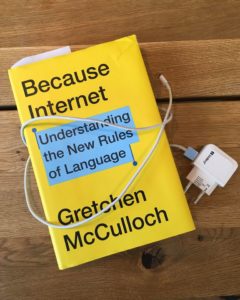 Already before reading Because Internet, I was a fan of Gretchen McCulloch from her blog, All Things Linguistics, and her podcast Lingthusiasm. So it’s with a certain bias that I declare myself unconditionally thrilled with her book.
Already before reading Because Internet, I was a fan of Gretchen McCulloch from her blog, All Things Linguistics, and her podcast Lingthusiasm. So it’s with a certain bias that I declare myself unconditionally thrilled with her book.
Because Internet concerns linguistic phenomena on the internet, and although the subject is explained in a style so laid-back that it’s ccasionally reminiscent of the very chat messages it investigates, there’s an obvious body of work in its scientific foundation. The book gives its reader some background knowledge, both of the history of the internet and a number of linguistic topics. Among other things, it has a really good chapter which explains sociolinguistics with some different examples from those typically found in textbooks.
The book builds on top of this with more recent studies, including a good deal of McCulloch’s own work – some interesting observations on emoji and chat messages, for example.
I recommend this book to anyone who’s been wondering why older (or younger) people use such a weird tone in their text messages.
MARK FORSYTH: THE ETYMOLOGICON (2016, 272 pages)
![]() The Etymologicon has a very simple, yet surprisingly effective basic premise. The entire book is one long list of etymological explanations of words from the English language. But Forsyth chooses his words carefully, so that there’s always a clever segue from one word etymology to the next, and his chosen words all have interesting and amusing stories behind them – stories which Forsyth tells with grace and enthusiasm. The book has next to no structure or progression, and you would think it would quickly become a monotonous read, but the reality is that I found it difficult to put down – there’s always time for just one more etymological anecdote.
The Etymologicon has a very simple, yet surprisingly effective basic premise. The entire book is one long list of etymological explanations of words from the English language. But Forsyth chooses his words carefully, so that there’s always a clever segue from one word etymology to the next, and his chosen words all have interesting and amusing stories behind them – stories which Forsyth tells with grace and enthusiasm. The book has next to no structure or progression, and you would think it would quickly become a monotonous read, but the reality is that I found it difficult to put down – there’s always time for just one more etymological anecdote.
I recommend this book for the linguist who’s always called upon at family gatherings to explain etymologies.
ANNE MARIE TRESTER: BRINGING LINGUISTICS TO WORK (2017, 168 pages)
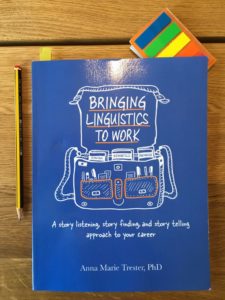 If you’re the kind of person who spends the summer reading up on next year’s coursework and updating your resumé, Bringing Linguistics to Work is good news. Anne Marie Trester, improv actor and career linguist, has written the book to inspire linguists to use their unique skills; not just when doing their jobs, but also when finding (or creating) exactly the jobs they want. To do this, she draws on her knowledge both as a linguist and as a skilled improvisor.
If you’re the kind of person who spends the summer reading up on next year’s coursework and updating your resumé, Bringing Linguistics to Work is good news. Anne Marie Trester, improv actor and career linguist, has written the book to inspire linguists to use their unique skills; not just when doing their jobs, but also when finding (or creating) exactly the jobs they want. To do this, she draws on her knowledge both as a linguist and as a skilled improvisor.
The book is divided into chapters describing different aspects of the job hunt. It contains a number of excercises throughout, as well as stories from what Trester dubs ‘career linguists’ about their professional lives and the choices that got them to where they are. For me, these stories were the highlights of the book, as they illustrated Tresters points well and gave good examples of how to use linguistics professionally.
Unlike the other books on this list, this one assumes some professional linguistic knowledge from the reader. The style of writing is not the most captivating, but to be fair, it’s hard to make a flashy subject out of personal job market optimisation (at least as far as I’m concerned). However, it helps that Trester uses linguistic terms throughout the book to explain her ideas. The author knows that she’s writing for a small, specific audience, and uses it to her advantage. The very specific knowledge required from the reader gives me a feeling that this book was written specifically for me; and this makes it far easier to get through than it might otherwise have been. I recommend this book for the linguist who’s considering making a LinkedIn profile.
JENNIFER KRONOVET: THE WUG TEST (2016, 76 pages)
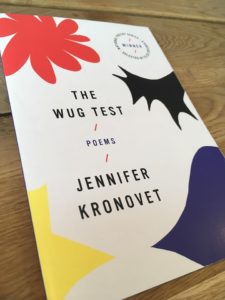 Before hearing of The Wug Test, I wouldn’t have thought any publisher would release such a niche book. Jennifer Kronovet has created a collection of poetry which draws on ideas from linguistics, such as the Sapir-Whorf Hypothesis, metaphor theory, and of course the eponymous Wug test. As a reader, among other things you’re introduced to “Ten Ways to Mourn a Dead Language”. The concept is altogether incredibly nerdy in a way that I find fantastically appealing.
Before hearing of The Wug Test, I wouldn’t have thought any publisher would release such a niche book. Jennifer Kronovet has created a collection of poetry which draws on ideas from linguistics, such as the Sapir-Whorf Hypothesis, metaphor theory, and of course the eponymous Wug test. As a reader, among other things you’re introduced to “Ten Ways to Mourn a Dead Language”. The concept is altogether incredibly nerdy in a way that I find fantastically appealing.
The poetry itself is not exclusively based on language science. There’s a loose sense of narrative outside of the linguistic aspects, and it’s worth appreciating as poetry in its own right beyond the amusing concept. However, a lot of the contents might go over the heads of a reader who isn’t familiar with a lot of popular linguistic theory, so there’s still a technical element involved.
I recommend this book for poetic souls and giant nerds.
DANIEL EVERETT: LANGUAGE: THE CULTURAL TOOL (2012, 327 pages)
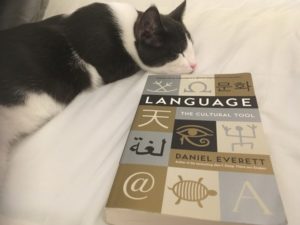 Daniel Everett, best known as champion of the Pirahã language and nemesis of Noam Chomsky, has written a book that, for me, invites plenty of discussion. Language: The Cultural Tool was an ideal book to engage the thinking-about-language part of my brain for as long as my studies weren’t doing that.
Daniel Everett, best known as champion of the Pirahã language and nemesis of Noam Chomsky, has written a book that, for me, invites plenty of discussion. Language: The Cultural Tool was an ideal book to engage the thinking-about-language part of my brain for as long as my studies weren’t doing that.
As a young student of linguistics, I’ve had – and am still having – difficulty finding my feet in the whole debate about Universal Grammar. There’s countless texts that argue for or against Chomskian theory, but practically everything I’ve read shares one feature: An unshakable attitude that their side of the debate is without doubt the correct one (and in science, you should of course never be without doubt). After reading the first chapter of this book, I had my hopes raised that I might actually have found a text that explains its arguments with an appropriate touch of self-criticism.
I’m sorry to say that the rest of the book sorely let me down. On a surface level, Everett appears to present his subject fairly and factually, but throughout the book, his own arguments triumph so consistently that I was left with a nagging feeling that he must surely have left something out. Don’t get me wrong: Although my opinions on the matter are far from those of an expert, I agree with Everett. I just don’t feel like I was given the option to disagree.
So if I don’t actually like the book, why am I recommending it? Language is exemplary in many other areas. Everett is a skilled narrator, and all the chapters have fun facts and anecdotes strewn across them, often from his own life, his work and his experience with the Pirahã people. It also contains a lot of amusing and thought-provoking phrasings, not to mention Everett’s apparently very useful approach to language as a cultural tool.
I can’t end a review of this book without mentioning its proofreader; namely, that I wish it had had one. The book is teeming with spelling errors, missing punctuation, and at least one very confusing missing suffix (p. 325).
I recommend this book for people who enjoy fieldwork anecdotes and having an opinion on Noam Chomsky.
DAVID BELLOS: IS THAT A FISH IN YOUR EAR? (2011, 353 pages)
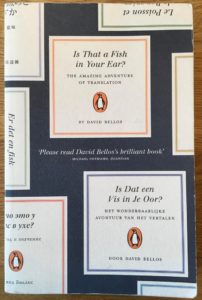 The final book on this list is both the longest in terms of page count and the most technically advanced. Is That a Fish in Your Ear? describes translation as a craft and a process, going through both the philosophical implications of translation (what does translation actually mean? Is a direct translation even possible?) as well as the details of many different genres of translation – fiction, news media and science, among many others. Bellos also discusses a number of other topics to do with translation: How do we program machines to translate? What exactly makes jokes so difficult to carry over into another language? And what influence have translation practices had throughout history?
The final book on this list is both the longest in terms of page count and the most technically advanced. Is That a Fish in Your Ear? describes translation as a craft and a process, going through both the philosophical implications of translation (what does translation actually mean? Is a direct translation even possible?) as well as the details of many different genres of translation – fiction, news media and science, among many others. Bellos also discusses a number of other topics to do with translation: How do we program machines to translate? What exactly makes jokes so difficult to carry over into another language? And what influence have translation practices had throughout history?
The book covers its subject from a long list of angles, leaving you with a feeling of having had it extremely thoroughly presented. The trade-off is that this makes the book slightly heavier to get through that most popular science books, with some of the chapters feeling almost like homework. I should mention, however, that my primary interest in translation is fiction, and the chapters that felt heavy to me were exactly the ones about specific non-fiction translation genres – so my experience here may be more on me than on Bellos.
Bellos’ book is worth reading if you’re just a little bit interested in translation, precisely because it describes all the major aspects with great precision and illustrative examples. I recommend the book for those who’ve read Asterix comics and admired not just the skill of the writer and artist, but also that of the translator.
With all that said, I hope that you’ve found a book or two that you might want to read during this summer break. If you’ve read any of these before, you’re welcome to leave your thoughts on them in the comments. And if you have any pop linguistics reading recommendations of your own, I’d very much like to hear about those, too! Happy reading!
Gustav Styrbjørn Johannessen studies Linguistics at Aarhus University. His interests include communicating Linguistics to a general audience, which he is currently doing as a student teacher for Det Rullende Universitet, as a member of the student group Linguistic Mythbusters and by writing the occasional entry for Lingoblog.







If I may, I’d like to add “Bastard Tongues” by Bickerton. His memoires are quite entertaining :)
Recently reviewed on Lingoblog:
https://www.lingoblog.dk/en/derek-bickerton-1926-2018-the-insular-linguist-and-his-work/
And then there’s Keeping Mum by Gwyneth Lewis (in English) and her Y Llofrudd Iaith (Welsh; the language murderer/killer). The work involves a murder mystery, in which Welsh is the victim of being murdered.